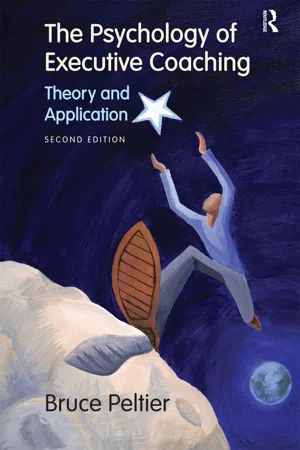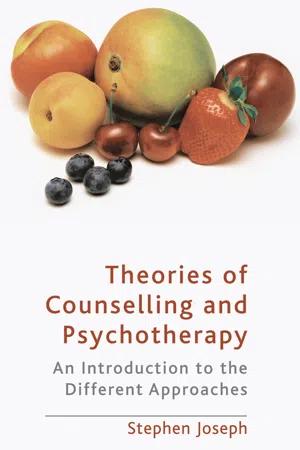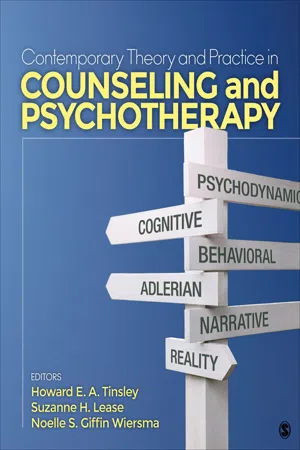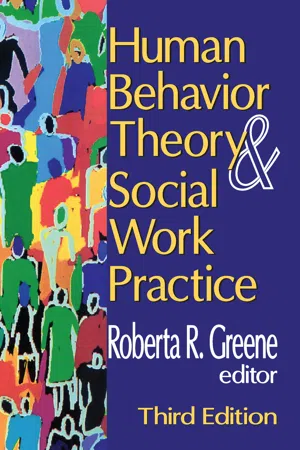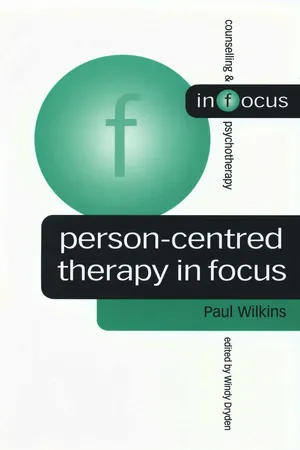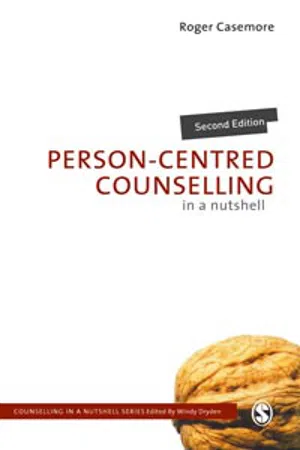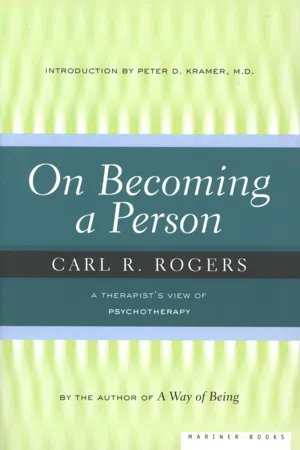Psychology
Client Centered Therapy
Client-centered therapy, developed by Carl Rogers, is a humanistic approach that emphasizes the therapist's empathetic understanding and unconditional positive regard for the client. The therapy focuses on the client's self-exploration and self-acceptance, with the therapist providing a supportive and non-directive environment for the client to work through their issues at their own pace.
Written by Perlego with AI-assistance
Related key terms
12 Key excerpts on "Client Centered Therapy"
- eBook - ePub
The Psychology of Executive Coaching
Theory and Application
- Bruce Peltier(Author)
- 2011(Publication Date)
- Routledge(Publisher)
The primary intent is for the helper to comprehend the client’s internal frame of reference and focus on the client’s perception of self and the world. Second, the person-centered approach is not rooted in a set of techniques or dogma. Rather, it is best seen as an attitude and belief system demonstrated by the therapist. It is both a way of being and a shared journey in which therapist and client reveal their humanness and participate in a growth experience.The Process: Therapeutic GoalsThe underlying aim of therapy is to provide a climate conducive to helping the individual become a healthy and fully functioning person. The person-centered approach places the primary responsibility for the direction of therapy on the client. The general goals of therapy are as follows:- Openness to experience (less defensive, more aware of reality)
- Achieving self-trust
- Internal source of evaluation (looking to oneself for the answers)
- Willingness to continue growing
The role of the person-centered therapist is grounded in a way of being, in an attitude, not in theory, knowledge, or techniques designed to get the client to do something or to change. Basically, the therapist creates a climate that allows the client to grow. First and foremost, the therapist must be willing to be real in the relationship with the client. The therapist does not diagnose or label; nor does the therapist give advice.Rogers’s view (1967) of the therapist’s job is “to give a client or person my full, caring attention without judging or evaluating them.”Rogerian counseling places demands on the counselor, and a coach should pay heed to these requirements. A person-centered approach requires a counselor who is able to be “present” in the counseling relationship. The counselor must be able to fully engage with the client, undistracted by personal agendas or roles, so that he or she can accurately experience that client. He or she cannot, therefore, be an agent of the company, attempting to mold their client according to company needs or the dictates of a boss. The counselor must also be able to demonstrate unconditional positive regard for the client, establishing no conditions for acceptance. The counselor must take a nonjudgmental attitude and communicate this attitude to the client. He or she must be able to achieve accurate empathy - eBook - ePub
Theories of Counselling and Psychotherapy
An Introduction to the Different Approaches
- Stephen Joseph(Author)
- 2010(Publication Date)
- Bloomsbury Academic(Publisher)
People seeking help from psychotherapists can be divided into two groups: those who wish to confront their difficulties and shortcomings and change their lives by changing themselves; and those who wish to avoid the inevitable consequences of their life strategies through the magical or tactical intervention of the therapist in their lives. Those in the former group may derive great benefit from therapy in a few weeks or months; those in the latter may stand still, or sink ever deeper into their self-created life morass, after meeting with psychotherapists for years, and even decades. (Szasz, 1974, pp. 108–9)The most well-known name associated with humanistic psychology is that of Carl Rogers (1902–1987) and it is his work we will first consider.Carl Rogers and the person-centred approach
Carl Rogers was a psychologist by training. One of his earliest achievements was to pioneer the recording of therapeutic sessions which he then used for research (Rogers, 1942). Throughout his life Rogers was a prolific writer, publishing numerous academic papers and books, many of which are still widely read today. In his book Client-centred Therapy , Rogers began to outline his approach to therapy (Rogers, 1951). He went on to describe his ideas in more detail in later papers as he elaborated on his theory of personality and therapy (Rogers, 1957, 1959). Over the years, Rogers began to apply his ideas derived from therapy in wider contexts, such as education, conflict resolution, and encounter groups (see Thorne, 1992). In order to recognize the broader applicability of his model the term person-centred came to replace the term client-centred - Howard E. A. Tinsley, Suzanne H. Lease, Noelle S. Giffin Wiersma(Authors)
- 2015(Publication Date)
- SAGE Publications, Inc(Publisher)
This statement highlights the radical nature of the person-centered model and shows a basic trust in clients to know for themselves what they need to attend to within psychotherapy. The quote makes no reference to “getting better” or “being treated” and suggests the therapist can rely on the client’s innate capacity to direct his or her own path to recovery and growth. This may be part of the reason that person-centered therapy does not appeal to many therapists. Some therapists want to be the one to have cured the client, to have been responsible for making the client grow or feel well again. Unfortunately for those therapists, it’s hard to find a place for that kind of thinking within the person-centered model. Person-centered therapists must learn to give up their own belief that they are more able to direct their clients to recovery than the clients themselves.The belief in the client’s basic trustworthiness lies in stark contrast to the medical model of disease, which pathologizes people’s experiences of distress. Many approaches to psychotherapy adhere to the medical model of thinking by treating specific disorders with specific variations of treatment approaches, but the person-centered model has remained countercultural in that respect. Rogers noted, “Person-centred theory is a meta-theoretical perspective to understanding the human condition. It is a radical and revolutionary perspective that is founded on the assumption that human beings have an inherent tendency towards growth, development and optimal functioning” (Joseph & Worsley, 2007, p. i). Consequently, person-centered therapy does not alter its approach to work with specific diagnoses, because the person, not the diagnosis, is the central focus.Theory of Personality Development and Change
In this section, we outline key features in the theory of personality development as well as the mechanisms underlying personality change.Development of Self-Concept and Conditional Regard
The person-centered approach emphasizes the phenomenological aspects of experiencing, and the individual’s subjective experience of the world is considered to be reality for the perceiver. This is another reason that person-centered therapists trust their clients’ knowledge about their experiences; their perceptions are the pertinent reality. At first the infant does not perceive any difference in its phenomenal field between self, parent, or environment. Through a process of increasing differentiation, the infant begins to perceive aspects of the phenomenal field as separate and the infant becomes aware of itself. As awareness develops, a structure of self- eBook - ePub
Portraits of Pioneers in Psychology
Volume III
- Michael Wertheimer, Gregory A. Kimble(Authors)
- 2013(Publication Date)
- Psychology Press(Publisher)
knowledgeable expert in more traditional talk therapies. The client-centered therapist neither instructs nor interprets, but encourages the help seeker to identify areas of exploration, choose personal goals, and set the pace of the therapy.A central component of Rogers’ conception of therapy is that clients can solve their personal psychological problems through self-exploration, which leads them to better self-understanding, provided that the therapist establishes and maintains the essential conditions of therapy. Proper therapeutic technique requires the therapist to be sensitive, accurate, empathie, and personally involved, and to frequently express comprehension of the person’s utterances and emotional substrate. The responses of the therapist must remain congruent with the feelings expressions of the client. These matchings of the therapist’s reactions to those of the client facilitate self-discovery and recovery and permit resumption of the tendencies toward personal growth that are associated with mental health. Successful therapy means recovering self-understanding and a sense of inner self. Acting in accord with the demands of that true self is to act in ways that are self-realizing (i.e., in ways that are productive and self satisfying because they represent correspondence between the person’s real self and its behavioral expressions).Guiding ValuesAlthough the emphases in Rogers’ programs shifted during the more than 50 years of his professional activity, all of them were guided by an enduring set of values. In his public addresses and in his writings, Carl Rogers was always an outspoken advocate of personal freedom and self-determination. He believed that being true to oneself requires the development of personal standards and the ability to behave in ways that are based on inner impulse and conviction rather than on the wishes of others. He detected these developments in his own life and explained them (Rogers, 1980) as at least in part reactions to the proscriptions and prescriptions implicit in his family’s fundamentalist Protestant religion. Whatever their sources, however, the theme of personal freedom was dominant in Rogers’ therapy, which emphasized the processes of discovering or recovering one’s true inner self. - eBook - ePub
Foundations of Counseling and Psychotherapy
Evidence-Based Practices for a Diverse Society
- David Sue, Diane M. Sue(Authors)
- 2012(Publication Date)
- Wiley(Publisher)
Humanistic therapies, with their focus on the client-therapist relationship and collaborative work with clients, have had a profound effect on the way therapy is conducted. Consistent with the humanistic philosophy, Hubble, Duncan, and Miller (1999) and Duncan and Miller (2000) believe that psychotherapy should be individualized and client directed. They believe that therapy is most effective when therapists:1. Work in a collaborative manner with clients2. View the change process as self-change3. Assess the client’s perspective regarding problems and their causes4. Tailor therapy to the client’s goals and solutions5. Utilize client competencies in therapy and credit them for making constructive changes6. Openly ask clients to give feedback regarding the therapist’s performanceAlthough client-centered techniques continue to influence therapist-client relationship variables emphasized in many manualized, evidence-based therapies, the humanistic therapies are threatened by experimental designs that stress objective measures. The advent of managed care—with its emphasis on clearly defined goals—along with the movement toward the use of empirically supported techniques, has greatly reduced the number of individuals who identify themselves as humanistic therapists. In a randomly selected group of psychotherapists, less than 6 percent identified themselves as having a primarily humanistic orientation (existential, Gestalt, client-centered) while the percentage was 14 percent in 1981 (Norcross, Hedges, & Castle, 2002). Although the pure forms of humanistic therapies are no longer widely practiced, many other therapeutic approaches incorporate their techniques and assumptions.The Client-Centered Approach
The form of psychotherapy introduced by Carl Rogers (1942) was revolutionary because of its contrast to the two main schools of therapy at the time—psychoanalytic therapy, with its emphasis on unconscious intrapsychic conflicts, and behavioral therapy, with the focus on stimulus and response. While humans were viewed as either “evil” or impulse driven in psychoanalysis or “neutral” in behavioral therapy, Rogers perceived human nature as “good” and humans as having the potential for self-actualization - eBook - ePub
- Roberta R. Greene, Roberta R. Greene(Authors)
- 2017(Publication Date)
- Routledge(Publisher)
Rogers, in reaction to the directive nature of traditional approaches to psychotherapy, began calling his therapeutic method “nondirective counseling.” This label was based on the idea that the client, not the counselor, should always take the lead in the helping process. From the beginning, Rogers (1959, 1942) emphasized that the client’s inherent potential for growth could be tapped if the helping person focused on the positive side of human nature.During the 1950s, Rogers (1951) began to develop a theory of personality and its application in counseling. With this change in emphasis, he renamed his therapeutic approach “client-centered therapy.” During this phase in Rogers’s (1957) work, he redefined his therapeutic goals. He suggested that entering a client’s “internal frame of reference” to help the client examine his or her feelings was the central purpose of the helping process. Rogers thought that the client’s understanding of his or her feelings led to positive behavioral change within the client’s environment.From the late 1950s to the early 1960s, Rogers and his associates conducted extensive research to test the major assumptions of the client-centered theory. Some researchers concluded that the client-centered method was most helpful for intelligent young people with “no more than mild anxiety complications” (White & Watt, 1981, p. 257). They also suggested that Rogers was valued most for his work in training counselors and psychotherapists in the conditions that facilitate the therapeutic relationship, and that many of Roger’s axioms, such as respect for the client, self-determination, and the need for empathic understanding, had become the “common sense” of therapeutic relationships (White and Watt, 1981, p. 257).The Rogerian approach is based on an optimistic, positive view of human nature.Throughout the 1960s and 1970s, Rogers’s (1970, 1972, 1977) interest and influence broadened. What first seemed to be a simple model became increasingly complex (Raskin, 1985). Among Rogers’s widening interests were the development of personal-growth groups and work with couples and families. Rogers also applied his ideas to administration, minority groups, interracial and intercultural groups, as well as to international relations. As a result of Rogers’s growing interest in how people obtain and share power and control, his method became known as the “person-centered approach.” - eBook - ePub
- Paul Wilkins(Author)
- 2002(Publication Date)
- SAGE Publications Ltd(Publisher)
Sanders’ (2000) helpful scheme for understanding who is and who is not covered by the umbrella of the person-centred approach implies that there is more than one way of being a person-centred therapist. This variety had been previously explored by Margaret Warner who asks whether the person-centred approach is one nation with many tribes. Warner (1998, reproduced in the ADPCA Reader 1999) explores the tension in the attitudes of those who claim to espouse the person-centred approach. She (p. 3) writes:Therapists disagree passionately as to what is really ‘client-centered’ or ‘person-centered’ and whether the two are the same. Some wouldinclude almost all therapies that have some emphasis on genuineness or empathy as client-centered, others would define the term client-centered therapy very narrowly, in ways that would limit its application to a much smaller group of practitioners – those who follow the radically nondirective elements evident in taped versions of Rogers’ psychotherapy practice.Warner (pp. 5–6) goes on to explore the arguments of a variety of therapists describing themselves as person-centred before reaching the conclusion, ‘the differences among these positions are substantial’. She (pp. 6–8) characterises psychotherapy as divided according to five ‘levels of interventiveness’. These are:Level 1: The therapist is in contact with the client without bringing anything from outside the client’s frame of reference . This she regards as ‘a largely hypothetical category’.Level 2: The therapist uses personal experiences and theories as a way to more fully understand the client’s frame of reference, without trying to influence or alter the client’s experience . This she describes as an attempt ‘to walk in the client’s shoes’. This is the position of classic client-centred therapists.Level 3: The therapist brings material into the therapeutic relationship in ways that foster the client’s choice as to whether and how to use such material - eBook - ePub
- Roger Casemore(Author)
- 2011(Publication Date)
- SAGE Publications Ltd(Publisher)
I do want to state here that I strongly respect the beliefs and value the good practice of counsellors from the psychodynamic and cognitive-behavioural approaches. I have had good personal experience of therapy from counsellors trained in those approaches. However, I do not feel able to practise those approaches myself because they do not sit well with my personal belief system about the nature of humanity, or with my nature and personality. In simple terms, the person-centred approach seems to fit me and to work well for me and the clients with whom I work.The basic philosophical assumptions
In my view, Rogers developed the person-centred approach to therapy from three distinctive philosophical beliefs: Humanism, Existentialism and Phenomenology. I believe that in order to understand the theory he developed, it is essential to understand and accept those philosophical roots, which I would like to briefly outline below.Humanism
This philosophy is based, first of all, on a fundamental attitude that emphasises the dignity and worth of each individual human being. Secondly, it is based on the belief that people are rational beings who possess within themselves the capacity for truth and goodness. The humanistic concept of the person is based on a model of growth, in which the person is seen as always striving to create, achieve or become. The need for self-fulfilment or self-actualisation is regarded as a fundamental human drive. From a humanistic point of view, fulfilment and growth are achieved through the search for meaning in life and not through supernatural claims. The humanistic view of the person as actively seeking meaning and fulfilment puts a strong focus on the concept of process. Self-actualisation or fulfilment is a continual challenge or journey to be experienced, not an end-state to be attained.This view of the nature of humanity directly contrasts with the conflict model implicit in psychodynamic theory, and the problem management or coping model implicit in behaviourism. It clearly figures in Rogers’ development of the concept of ‘A Way of Being’ and his notion of ‘Becoming a Person’, the titles of two of his most well-known books (Rogers, 1961,1980). - eBook - ePub
On Becoming A Person
A Therapist's View of Psychotherapy
- Carl Rogers(Author)
- 2012(Publication Date)
- Mariner Books(Publisher)
Another reason for whatever effectiveness the system has had in mediating research, is that the constructs have generality. Because psychotherapy is such a microcosm of significant interpersonal relationship, significant learning, and significant change in perception and in personality, the constructs developed to order the field have a high degree of pervasiveness. Such constructs as the self-concept, or the need for positive regard, or the conditions of personality change, all have application to a wide variety of human activities. Hence such constructs may be used to study areas as widely variant as industrial or military leadership, personality change in psychotic individuals, the psychological climate of a family or a classroom, or the inter-relation of psychological and physiological change.One final fortunate circumstance deserves mention. Unlike psychoanalysis, for example, client-centered therapy has always existed in the context of a university setting. This means a continual process of sifting and winnowing of the truth from the chaff, in a situation of fundamental personal security. It means being exposed to the friendly criticism of colleagues, in the same way that new views in chemistry or biology or genetics are subjected to critical scrutiny. Most of all it means that the theory and the technique are thrown open to the eager searching of younger minds. Graduate students question and probe; they suggest alternative formulations; they undertake empirical studies to confirm or to disprove the various theoretical hypotheses. This has helped greatly to keep the client-centered orientation an open and self-critical, rather than a dogmatic, point of view.It is for reasons of this sort that client-centered therapy has built into itself from the first the process of change through research. From a limited viewpoint largely centered on technique, with no empirical verification, it has grown to a ramifying theory of personality and interpersonal relations as well as of therapy, and it has collected around itself a considerable body of replicable empirical knowledge. - eBook - ePub
Person-Centred Therapy
The Focusing-Oriented Approach
- Campbell Purton(Author)
- 2017(Publication Date)
- Bloomsbury Academic(Publisher)
1
Rogers and the Development of Person-Centred Therapy
Rogers’ work
In his book Counselling and Psychotherapy : Newer Concepts in Practice , published in 1942, Carl Rogers presents what he sees as a new method of therapy ‘in which warmth of acceptance and absence of any form of coercion or personal pressure on the part of the counsellor permits the maximum expression of feelings, attitudes, and problems by the counsellee . . . In this unique experience of complete emotional freedom within a well-defined framework the client is free to recognise and understand his impulses and patterns, positive and negative, as in no other relationship’ (Rogers, 1942, p. 113). The book contains the first complete recorded transcript of a series of therapy sessions, with a commentary by Rogers on how the therapist’s responses in the session embodied the non-directive principles which Rogers was advocating.During the following few years, while Rogers was based at Ohio State University, he and other therapists applied the principles of non-directive responding in a variety of contexts, including work with the adjustment problems of servicemen returning from wartime activities. It was in his next book (co-authored with John Wallen) Counselling with Returned Servicemen (1946) that Rogers first used the term ‘client-centred’, along with ‘non-directive’, as characterising his approach. It is the client’s frame of reference which is emphasised, while ‘[i]t is the counsellor’s function to provide an atmosphere in which the client, through the exploration of his situation, comes to see himself and his reactions more clearly and to accept his attitudes more fully’ (Rogers and Wallen, 1946, p. 5). What the counsellor actually did - eBook - ePub
Person-Centred Counselling Psychology
An Introduction
- Ewan Gillon(Author)
- 2007(Publication Date)
- SAGE Publications Ltd(Publisher)
THREE A Person-centred Theory of Psychological Therapy IntroductionAs we saw in the previous chapter, Rogers’ (1959) theory of personality posited incongruence between organismic experiencing and the self-concept as the sole cause of all psychological disturbance. Following on from such a view, it is the reduction of incongruence that is associated with greater psychological well-being and, as such, provides the rationale for a person-centred approach to psychological therapy. In this chapter we shall explore the person-centred therapeutic approach, highlighting how it works to reduce incongruence in the ways initially described by Rogers (1957), as well as those subsequently developed by others within the framework (e.g. ‘experiential’ practitioners)A theory of therapySince first outlining his ideas for psychotherapy in the early 1940s, Carl Rogers consistently highlighted the role of the relationship between client and counsellor as of primary significance in therapeutic practice. This was a stance that evolved from his own experiences of working as a psychologist, and informed by his awareness of a wide range of other psychological theories and approaches. Rogers saw an effective therapeutic relationship as denoted by the presence of a systematic series of counsellor attitudes in conjunction with certain factors primarily linked to the client. If each of these dimensions were in place, he argued it was inevitable that psychological growth would occur.In 1957 he published a paper entitled ‘The Necessary and Sufficient Conditions of Therapeutic Personality Change’ in which he detailed six conditions which were ‘necessary and sufficient’ for psychological change to occur within a client. Rogers deliberately used the word sufficient - eBook - ePub
- Fay Short, Phil Thomas(Authors)
- 2014(Publication Date)
- Routledge(Publisher)
• describe how the therapist uses genuineness, transparency and self-disclosure to demonstrate the core condition of congruence• describe how the therapist uses a non-judgemental approach and sensitive cultural awareness to demonstrate the core condition of unconditional positive regard• describe how the therapist enters the client’s frame of reference by using primary and advanced empathy to demonstrate the core condition of empathic understandingAbsence of techniques
Successful therapy is not dependent on techniques
Successful therapy is dependent purely on the nature of the therapeutic relationship Constructive personality change requires only that the client and therapist engage in a positive therapeutic relationship Person-centred therapy involves simply being with the client No use of games, exercises, activities, homework, etc. Various methods can be taught and utilised to improve skills in communicating the core conditions of congruence, unconditional positive regard and empathy But these are simply interpersonal skills, rather than specific therapeutic techniques to be followed according to the instructionsAs noted by Thorne (1996), Rogers was horrified to find that the focus on the responses of the therapist became a list of techniques – the whole purpose of person-centred therapy is to be genuine in that moment, rather than to follow a set of protocols according to the bookTherapeutic relationship is more important than therapeutic techniques
Research exploring common factors across multiple types of therapy has often focused on the core conditions of person-centred therapy (Lambert & Barley, 2001)
Index pages curate the most relevant extracts from our library of academic textbooks. They’ve been created using an in-house natural language model (NLM), each adding context and meaning to key research topics.
